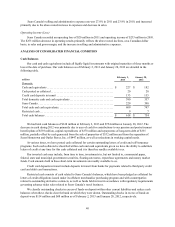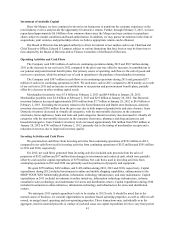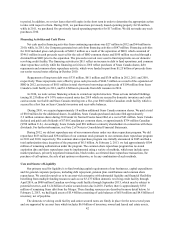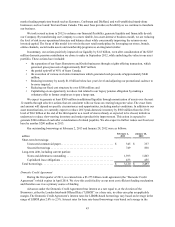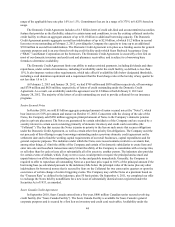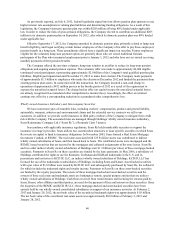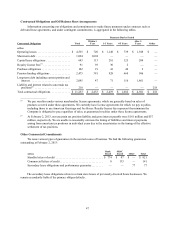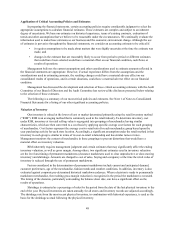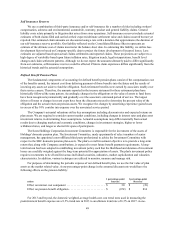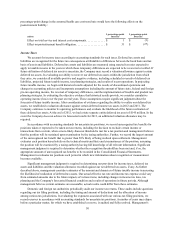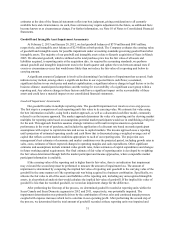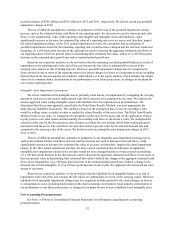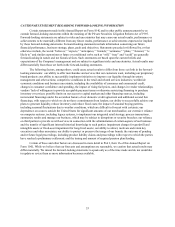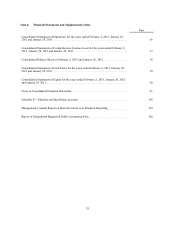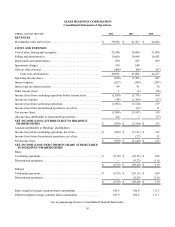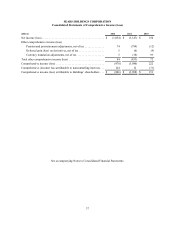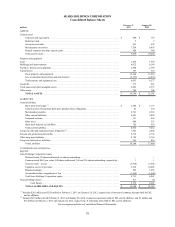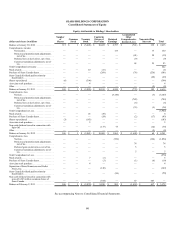Sears 2012 Annual Report Download - page 50
Download and view the complete annual report
Please find page 50 of the 2012 Sears annual report below. You can navigate through the pages in the report by either clicking on the pages listed below, or by using the keyword search tool below to find specific information within the annual report.
50
percentage-point change in the assumed health care cost trend rate would have the following effects on the
postretirement liability:
millions 1 percentage-point
Increase 1 percentage-point
Decrease
Effect on total service and interest cost components. . . . . . . . . . . . . $ 1 $ (1)
Effect on postretirement benefit obligation . . . . . . . . . . . . . . . . . . . . $ 31 $ (27)
Income Taxes
We account for income taxes according to accounting standards for such taxes. Deferred tax assets and
liabilities are recognized for the future tax consequences attributable to differences between the book basis and tax
basis of assets and liabilities. Deferred tax assets and liabilities are measured using enacted tax rates expected to
apply to taxable income in the years in which those temporary differences are expected to be recovered or settled. If
future utilization of deferred tax assets is uncertain, the Company may record a valuation allowance against certain
deferred tax assets. In evaluating our ability to recover our deferred tax assets within the jurisdiction from which
they arise, we consider all available positive and negative evidence, including scheduled reversals of deferred tax
liabilities, projected future taxable income, tax planning strategies, and results of recent operations. In projecting
future taxable income, we begin with historical results adjusted for the results of discontinued operations and
changes in accounting policies and incorporate assumptions including the amount of future state, federal and foreign
pre-tax operating income, the reversal of temporary differences, and the implementation of feasible and prudent tax
planning strategies. In evaluating the objective evidence that historical results provide, we consider cumulative
operating income (loss) over the past several years. These assumptions require significant judgment about the
forecasts of future taxable income. After consideration of evidence regarding the ability to realize our deferred tax
assets, we established a valuation allowance against certain deferred income tax assets in 2012 and 2011. The
Company continues to monitor its operating performance and evaluate the likelihood of the future realization of
these deferred tax assets. At the end of 2012, we had a state separate entity deferred tax asset of $145 million. In the
event the Company does not achieve its forecasted results for 2013, an additional valuation allowance may be
required.
In accordance with accounting standards for uncertain tax positions, we record unrecognized tax benefits for
positions taken or expected to be taken on tax returns, including the decision to exclude certain income or
transactions from a return, when a more-likely-than-not threshold is met for a tax position and management believes
that the position will be sustained upon examination by the taxing authorities. Further, we record the largest amount
of the unrecognized tax benefit that is greater than 50% likely of being realized upon settlement. Management
evaluates each position based solely on the technical merits and facts and circumstances of the position, assuming
the position will be examined by a taxing authority having full knowledge of all relevant information. Significant
management judgment is required to determine whether the recognition threshold has been met and, if so, the
appropriate amount of unrecognized tax benefits to be recorded in the Consolidated Financial Statements.
Management reevaluates tax positions each period in which new information about recognition or measurement
becomes available.
Significant management judgment is required in determining our provision for income taxes, deferred tax
assets and liabilities and the valuation allowance recorded against our net deferred tax assets, if any. As further
described above, management considers estimates of the amount and character of future taxable income in assessing
the likelihood of realization of deferred tax assets. Our actual effective tax rate and income tax expense could vary
from estimated amounts due to the future impacts of various items, including changes in income tax laws, tax
planning and the Company's forecasted financial condition and results of operations in future periods. Although
management believes current estimates are reasonable, actual results could differ from these estimates.
Domestic and foreign tax authorities periodically audit our income tax returns. These audits include questions
regarding our tax filing positions, including the timing and amount of deductions and the allocation of income
among various tax jurisdictions. In evaluating the exposures associated with our various tax filing positions, we
record reserves in accordance with accounting standards for uncertain tax positions. A number of years may elapse
before a particular matter, for which we have established a reserve, is audited and fully resolved. Management's


